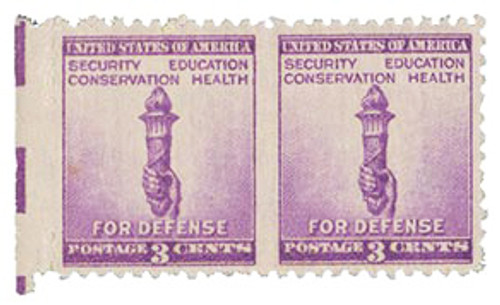U.S. #525c- Horizontal Imperf Pair
1918-20 1¢ Washington
Issue Date: December 1918
Printed by: Bureau of Engraving and Printing
Method: Offset printing
Watermark: None
Perforation: 11
Color: Gray green
U.S. #525 was printed on plates of 400 and 1600 subjects. The Series of 1918-1920 1¢ Washington stamps, including U.S. #525, all used the same design type. With the increase in postal rate during World War I, they often made up the new 3¢ rate when combined with common 2¢ stamps.
Offset Printing
The Bureau of Engraving and Printing experimented with a printing method known as “offset printing” to increase production and save money. Photographs of a die proof used for flat plate and rotary stamps were enlarged and “re-touched” to make the details clearer. A photo negative of the altered image was then shrunk back to normal size and placed on a sensitized plate, one after the other. Next, an entire “mask” (image) of the plate was used to create the offset plates.
This allowed the bureau to create plates of much greater size than possible with the engraved method. Plates contained 400, 800, or 1600 stamp subjects.
Identifying Offset Printed Stamps
The ink on offset printed stamps feels smooth and flat. Stamps made by an engraved flat plate or rotary press have a textured feel, due to the raised ink on the surface. Offset printed stamps also often have poor-quality images. They typically don’t have as distinct detail as engraved stamps. Double-printed stamps were also relatively common. Sometimes sheets were so lightly printed they were run through again to save paper.
Series of 1917-20 Stamps
Lack of funds and materials during the war caused the Bureau of Engraving and Printing to experiment with various printing methods. In addition to the rotary press, the new offset printing was tried.
In November of 1917, the first class postage rate was changed from two cents to three cents, causing the demand for the 3¢ stamp to soar. Demand for the 1¢ stamp, to use along with the 2¢ stamp, also increased. In order to keep up with the public’s requests, the Bureau was operating at full capacity.
Inability to obtain the materials from Germany to produce a quality ink resulted in the use of inferior inks. These inks, which contained grit, were abrasive and had a tendency to wear out the plates faster. The average life of a plate was 10 days. They were wearing out faster than the Bureau could make them! Besides reducing the wear and tear on the plates, offset printing was advantageous because plates for this process could be made much quicker.
One of the negative aspects of using this method, however, was a less defined and somewhat blurry image. Some designs were modified in order to achieve a better impression. Eventually, a better grade of ink was found and stamps were once again printed by the higher-quality engraving process.
Following the war, many countries had depleted their resources. Items such as food, clothing, and machinery were greatly needed, and the U.S. responded by sending shipments of supplies to the war-torn countries of France, Russia, and other nations. High-value stamps were needed to prepay postage and registry on international packages, and it was decided to release stamps with both $2 and $5 denominations. The sudden demand for these issues, however, did not allow time for new designs to be prepared. So, the designs from the 1902 series were used. Identical in color and design, the 1917 issues can be distinguished by their lack of a watermark.
In 1918, the Bureau finally found the time to prepare new designs. On August 19th, the $2 and $5 stamps were released carrying portraits of Ben Franklin. In addition to being printed horizontally, they were also printed using two colors. The changes were made so postal clerks could easily tell the difference between these stamps and the lower denominations.
The $2 stamp was approved in dark red; however, due to an error, it was first printed in orange. Unfortunately, the error was not discovered until the stamps had been printed and distributed. When the Bureau received the proper ink, the stamps were printed in the intended color and redistributed. Collectors, however, not realizing the orange version was the error, stocked up on the dark red issue. Today, this error is extremely scarce. Although the shades of green on the $5 issue vary somewhat, they are all classified as deep green.








